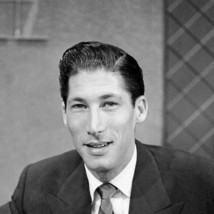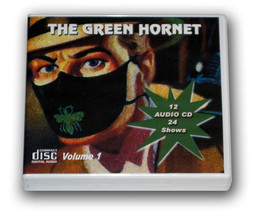Barry Gray Show - Old Time Radio - 1 Cd - 6 and 50 similar items
Free Shipping
10 recent views
BARRY GRAY SHOW - OLD TIME RADIO - 1 CD - 6 mp3 - Total Playtime: 3:08:24
$6.79
View full item details »
Shipping options
Estimated to arrive by Mon, Apr 28th.
Details
FREE via USPS Ground Advantage (2 to 3 business days) to United States
Return policy
Full refund available within 30 days
Purchase protection
Payment options
PayPal accepted
PayPal Credit accepted
Venmo accepted
PayPal, MasterCard, Visa, Discover, and American Express accepted
Maestro accepted
Amazon Pay accepted
Nuvei accepted
View full item details »
Shipping options
Estimated to arrive by Mon, Apr 28th.
Details
FREE via USPS Ground Advantage (2 to 3 business days) to United States
Return policy
Full refund available within 30 days
Purchase protection
Payment options
PayPal accepted
PayPal Credit accepted
Venmo accepted
PayPal, MasterCard, Visa, Discover, and American Express accepted
Maestro accepted
Amazon Pay accepted
Nuvei accepted
Item traits
| Category: | |
|---|---|
| Quantity Available: |
46 in stock |
| Condition: |
Unspecified by seller, may be new. |
Listing details
| Shipping discount: |
No combined shipping offered |
|---|---|
| Posted for sale: |
More than a week ago |
| Item number: |
424143609 |
Item description
BARRY GRAY SHOW
OLD TIME RADIO - 1 CD - 6 mp3 - Total
Playtime: 3:08:24
Barry Gray (born Bernard Yaroslaw;
July 2, 1916; Red Lion, New Jersey – December 21, 1996)
was an influential American radio personality, often
labeled as "The father of Talk Radio".
Initially a disc jockey, Gray was working for New York's
WMCA radio station in 1945 when he, bored one evening
with simply spinning music, decided to put the telephone
receiver up to his microphone and share his conversation
with the listening audience. The caller that evening
just happened to be bandleader Woody Herman, one of the
most popular celebrities of the day. This spontaneous
live interview was such a hit with both his listeners as
well as station bosses, that the talk radio format
resulted. Gray subsequently began doing listener
call-ins as well.
However, the technical aspects of early Cold War
broadcasting were challenged by the live call-in,
over-the air format. U.S. government restrictions and
problematic consequences could not stop Gray's talk show
success in putting listeners on the air ... with or
without WMCA and the government's permission. His
audience loved it, and grew exponentially.
Rival station WOR also saw the attraction of the talk
format, and Gray worked an overnight shift there from
1945 to 1948 or 1949, interviewing everyone from Al
Jolson to Adam Clayton Powell, Jr. He also broadcast for
WMGM from the Copacabana night club in the late 1940s.
Gray broadcast on WMIE AM radio from three Miami Beach
nightclubs, the Copa Lounge, Danny and Doc's Jewel Box
and the Martha Ray Club nightly in the fall of 1948 and
into 1949 before he left the Miami area under some
pressure. Gray bopped someone from his audience with his
microphone, and this happened on the air. The impact was
audible and the impact had been preceded by hot words of
anger. This report of recollection fifty-eight years
later comes from Ernest W. Bennett of Miami, Florida,
who listened to Gray's broadcast every weeknight,
beginning in Bennett's sophomore year at the University
of Miami in the fall of 1948. Carl Warner, a retired
newspaper publisher living in Clinton, Tennessee, was
then the remote engineer for the Barry Gray Miami Beach
broadcasts. He also recalls the bopping-mike incident.
He remembers hearing a loud bang in his headphones and
looking up to the Copa Lounge stage seeing the podium
turned over and Barry signaling him to cut the mikes.
After about 30 seconds of dead air, he asked for his
mike to be turned on.
Bennett recalls that period, and recalls from memory
other reports of Gray's other pugnacious altercations,
the final one, the audible one, was what apparently
impelled Gray's departure. Gray said himself as Bennett
recalls the exciting live-broadcast event, "I just hit
the guy over the head with my microphone, folks." In
this case the victim had been the aggressor toward Gray.
The so-called victim was Reubin Clein, publisher of
Miami Life. Reubin Clein was considered an agitator and
generally an aggressive character. He was a former
boxer; there were many in Miami who felt Clein should
have been put in his place, but no one would ever mess
with him because he was one of toughest people you would
ever meet. Clein was always into Wild West characters
and would often wear a cowboy hat, boots and would have
a big wooly beard. A generally gentle person would not
take crap from anyone and actually broke the mayor's
nose at a political rally.
According to Bennett, Gray was popular on Miami radio:
"He was very big here; number one, like Larry King is
known today. Indeed, Larry King began his broadcasting
career from a houseboat anchored in front of the Miami
Beach Fountainbleau Hotel in 1957."
Barry Gray returned to WMCA in 1950, and stayed there
for 39 years, refining the talk show format still
utilized today. During the 1960s, he was in the odd
position of having an 11 p.m.-1 a.m. late night talk
show on a station otherwise dominated by Top 40 music
and the youth-targeted "Good Guys" disc jockey campaign.
But for teenagers who kept their radios on into the
night, Gray's show was a window into the high-brow New
York culture of the 1940s and 1950s. Gray would often
have authors on, and he made a point of saying he had
actually read their books, something not all talk show
hosts did. Gray also had a tendency towards risqué (for
the time) topics, such as the novel nudity found in
European films playing in art houses, or characteristics
of the prostitution scene in Manhattan.
He was also known as a fierce critic of bigotry and
survived the ugliness of McCarthyism and the Red Scare.
A constant target of the blacklisting right-wing
columnist Walter Winchell, who called him "Borey Pink"
and "a disk jerk" in the 1950s, Barry was fearless in
calling out those he found mired in hypocrisy and
abusive in power. The Winchell feud seemed to haunt him,
however; years after Winchell had lost influence and
become a recluse, Gray would still talk darkly on air
about plots and physical attacks Winchell had
orchestrated against him. Indeed, a 1995 biography of
Winchell would report that he kept a photograph of a
bloodied Gray on his walls.
After WMCA changed to an all-talk format in 1970, Gray
was again fully in his element. He never backed away
from discussing hot topics in politics, especially those
that affected New Yorkers. A 1973 profile described him
as "brash, abrasive [and] opinionated. [He] was the
talk-show titan listeners love to hate, [and] is still
going after more than a quarter of a century at the
mike." By the 1980s he had shifted from a late-night to
a mid-day slot at the station.
Gray left WMCA in 1989 when it dropped its talk format,
and went to work slightly up the dial for a return to
WOR where he enjoyed national syndication. By the time
of his passing, his show was considered to be
politically conservative.
Gray appeared as his disc jockey self in the 1949 short
subject Spin That Splatter. Gray also pioneered in early
television, first as the host of The Barry Gray Show on
New York WOR-TV when Channel 9 went on the air in 1949,
then more visibly as host of the very first Goodson and
Todman game show Winner Take All, replacing Bud Collyer
in 1951. The Game Show Network airs these very rare
episodes every now and then, and they are informative:
Gray's hosting style has more in common with today's
David Letterman and Conan O'Brien than the classic
television game show hosts of yesteryear.
In 2002, industry publication Talkers magazine selected
Barry Gray as the 8th greatest radio talk show host of
all time.
SHOWS LIST
Barry Gray Show 46-10-27 Guest - Al Jolson
Barry Gray Show 47-06-14 Guest - Victor Moore
Barry Gray Show 49-09-23 Guest - Canada Lee Mac Clark
Barry Gray Show 49-09-30 Guest - Adam Clayton Powell
Barry Gray Show 49-10-07 Barry Went To See 'Death Of A
Salesman'
Barry Gray Show 49-10-14 Guest - Milton Berle
Be Aware:
MP3 CD WILL NOT PLAY IN REGULAR CD PLAYERS.
Mp3 CD will play in mp3 CD players and car mp3 CD players.
You can, also, upload the mp3 files to your ipod or itunes.
Will, also, play in your computer, some regular DVD players
and all Blu Ray Players.
PUBLIC DOMAIN NOTE
This item is the public domain and was created between January 1, 1923 and
December 31, 1971
This item is in the public domain due to failure to comply with required
formalities
After a careful search of the Library of Congress and the United States
Trademark and Patent Office, it has been determined that the programs listed
for sale here are in the Public Domain. They are being offered with the
understanding that no valid or active copyright, trademark, and/or patent
exist for them. These recordings are sold for private home listening and use
only. No broadcast rights are stated, implied, or given. I assume no
responsibility for unauthorized use of these programs. They are listed in
accordance with current policies concerning selling Public Domain
materials.
|
Why are we showing these items?
Booth
OLD TIME RADIO AND FILM COLLECTIONS |

|

-
Refine your browsing experience
We can show you more items that are exactly like the original item, or we can show you items that are similar in spirit. By default we show you a mix.
This item has been added to your cart
 BARRY GRAY SHOW - OLD TIME RADIO - 1 CD - 6 mp3 - Total Playtime: 3:08:24 added to cart.
46 available in stock
BARRY GRAY SHOW - OLD TIME RADIO - 1 CD - 6 mp3 - Total Playtime: 3:08:24 added to cart.
46 available in stock
View Cart or continue shopping.
 Please wait while we finish adding this item to your cart.
Please wait while we finish adding this item to your cart.
Get an item reminder
We'll email you a link to your item now and follow up with a single reminder (if you'd like one). That's it! No spam, no hassle.
Already have an account?
Log in and add this item to your wish list.























































